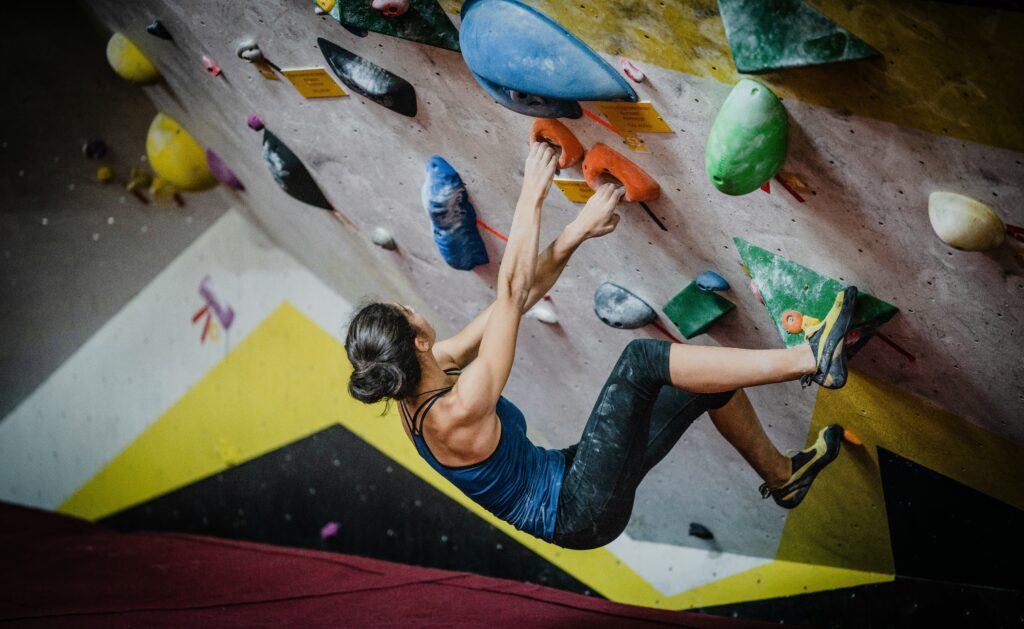Indoor Wall Climbing Can Help Your Running

Indoor wall climbing has emerged as a popular cross-training activity for runners, offering several benefits that extend beyond just cardiovascular endurance and leg strength. What many runners don’t realize is that indoor wall climbing engages the body and mind in ways that running alone cannot. It provides a full-body workout that can enhance a runner’s performance, reduce the risk of injury, and inject variety into their training regimen.
As the winter season is upon us, it can be challenging and dangerous to exercise outdoors. Many areas are dealing with ice and snow, prompting runners to seek indoor workout alternatives. Traditional gym workouts can become boring, leading many to search for more interesting ways to exercise that don’t involve stationary machines. Indoor wall climbing is becoming increasingly popular, offering substantial benefits for runners. If you are looking for other interesting cross-cross-training activities, consider the stationary bicycle or rowing.
So, how do runners benefit from indoor wall climbing?
Complementary Muscle Engagement
Running primarily targets the lower body, engaging muscles like the quadriceps, hamstrings, calves, and glutes. These muscles are important for a runner’s speed and endurance, but neglecting the upper body and core can lead to potential injuries. Indoor wall climbing demands significant upper body strength, particularly from the back, shoulders, and arms.
The gripping and pulling motions required for indoor wall climbing develop forearm strength and grip endurance, which are often overlooked in running-focused training programs. Unlike running, where we aren’t gripping anything unless it’s a gel or water cup, climbing engages these critical muscles.
Climbing also requires core engagement to maintain balance and stability on the wall. This strengthens the abdominal and lower back muscles, contributing to better posture and more efficient running form. A strong core is essential for runners as it improves stability during the landing phase of each stride. A strong core also reduces the risk of overuse injuries by distributing impact forces more evenly across the body.
Balance and Coordination
Wall climbing challenges the body’s balance and coordination in unique ways. The routes in indoor wall climbing are not linear, requiring “proprioception” – the sense of body position and movement in space. Without it, reaching the top would be impossible. Improved proprioception can help runners navigate uneven terrain, like trail running, more confidently and efficiently, making them less prone to missteps and falls.
The dynamic nature of climbing, where no two routes are exactly the same, also sharpens cognitive skills and decision-making abilities. Runners can benefit from this mental agility, learning to make quick and efficient decisions on the go, whether it’s adjusting their stride on an uneven path or devising a strategy during a race.
ADVERTISEMENT

Injury Prevention and Rehabilitation
Many runners choose cross-training for injury prevention and rehabilitation. Wall climbing is an excellent cross-training activity for runners! By diversifying the types of physical stresses placed on the body, runners can avoid the repetitive strain injuries often associated with high-mileage running programs. Climbing’s varied movements can help balance muscle development and flexibility, reducing the risk of common running injuries such as IT band syndrome, shin splints, plantar fasciitis, and runner’s knee.
For runners recovering from lower-body injuries, indoor climbing offers a way to maintain fitness without placing stress on healing tissues. The non-impact nature of climbing allows for continued cardiovascular and muscular engagement without the jarring forces experienced during running.
Mental Resilience and Stress Relief
Running and climbing share a common thread in their mental demands, both requiring focus, determination, and resilience. The problem-solving aspect of climbing, combined with the physical challenge, can enhance a runner’s mental toughness. Overcoming difficult routes instills a sense of achievement and confidence that is transferable to running. Climbing a difficult route provides the same high as completing a challenging race!
Additionally, the concentration required to climb effectively can serve as a form of meditation, providing mental clarity and stress relief. This mental break from the rigors of running can rejuvenate a runner’s enthusiasm for their sport and prevent burnout. Any form of cross-training is going to help with running burnout.
Social and Recreational Benefits
Did you know there are big indoor climbing communities? Indoor climbing gyms offer a social environment that can be refreshing for runners accustomed to training alone. The supportive climbing community fosters camaraderie. Even if you are new, indoor climbing communities will welcome you!
Participating in a different sport can also reignite a runner’s love for working out by presenting new challenges and achievements outside of completing a race or achieving a personal best.
Incorporating indoor wall climbing into a runner’s training regimen can provide a well-rounded workout. Runners can build strength, improve balance and coordination, aid in injury prevention, and enhance mental resilience and stress relief. Whether as a regular cross-training activity or an occasional alternative, indoor wall climbing is a valuable addition to any runner’s training, promising benefits that extend well beyond the climbing wall.
ADVERTISEMENT

Hollie is a runner, hiker, swimmer, residing in California. She has worked in run specialty for nearly 8 years and has fit hundreds of people for shoes. Outside of the running world, she enjoys the general aviation world, her two cats, and spending time with her spouse.








